Composite Structure of Ag Colloidal Particles and Au Sinusoidal Nanograting with Large-Scale Ultra-High Field Enhancement for SERS Detection
Abstract
:1. Introduction
- (1)
- High field enhancement. There are a lot of hot spots in the dimer and gaps between the nanoparticles and the grating surface.
- (2)
- Fabrication friendliness. The sinusoidal nanograting can be easily fabricated over a large area using the currently established dual-laser interferometric lithography method, avoiding the expensive and time-consuming electron beam-based nano-fabrication method. AuSG with pattern periodicity has the advantage over the random configuration of surface structures due to its reproducibility and pattern scalability.
- (3)
- Continuous detection. Combining colloidal AgNPs with continuous flow microfluidics helps trap the analyte at the detection area [23], which is important for SERS detection. The flowing AgNPs also help resolve the problem of memory effects and make the composite SERS substrate reusable.
2. Model and Theoretical Analysis
2.1. Theoretical Analysis
2.2. FDTD
3. Results
3.1. Double Enhancement
3.2. Large-Scale Field Enhancement
3.3. Ultra-High Field Enhancement
3.4. Experiment
4. Conclusions
Author Contributions
Funding
Institutional Review Board Statement
Informed Consent Statement
Data Availability Statement
Conflicts of Interest
References
- Cao, Y.W.C.; Jin, R.; Mirkin, C.A. Nanoparticles with Raman spectroscopic fingerprints for DNA and RNA detection. Science 2002, 297, 1536–1540. [Google Scholar] [CrossRef] [PubMed] [Green Version]
- Zhang, C.; Man, B.Y.; Jiang, S.Z.; Yang, C.; Liu, M.; Chen, C.S.; Li, Z. SERS detection of low-concentration adenosine by silver nanoparticles on silicon nanoporous pyramid arrays structure. Appl. Surf. Sci. 2015, 347, 668–672. [Google Scholar] [CrossRef]
- Xu, J.; Li, C.; Si, H.; Zhao, X.; Wang, L.; Jiang, S.; Zhang, C. 3D SERS substrate based on Au-Ag bi-metal nanoparticles/MoS2 hybrid with pyramid structure. Opt. Express 2018, 26, 21546–21557. [Google Scholar] [CrossRef] [PubMed]
- Li, C.; Yu, J.; Xu, S.; Jiang, S.; Xiu, X.; Chen, C.; Zhang, C. Constructing 3D and Flexible Plasmonic Structure for High-Performance SERS Application. Adv. Mater. Technol. 2018, 3, 1800174. [Google Scholar] [CrossRef]
- Ma, P.; Liang, F.; Diao, Q.; Wang, D.; Yang, Q.; Gao, D.; Wang, X. Selective and sensitive SERS sensor for detection of Hg2+ in environmental water base on rhodamine-bonded and amino group functionalized SiO2-coated Au-Ag core-shell nanorods. RSC Adv. 2015, 5, 32168–32174. [Google Scholar] [CrossRef]
- Li, J.F.; Anema, J.R.; Wandlowski, T.; Tian, Z.Q. Dielectric shell isolated and graphene shell isolated nanoparticle enhanced Raman spectroscopies and their applications. Chem. Soc. Rev. 2015, 44, 8399–8409. [Google Scholar] [CrossRef] [Green Version]
- Li, C.; Xu, S.; Yu, J.; Li, Z.; Li, W.; Wang, J.; Zhang, C. Local hot charge density regulation: Vibration-free pyroelectric nanogenerator for effectively enhancing catalysis and in-situ surface enhanced Raman scattering monitoring. Nano Energy 2021, 81, 105585. [Google Scholar] [CrossRef]
- Zhao, X.; Liu, C.; Yu, J.; Li, Z.; Liu, L.; Li, C.; Zhang, C. Hydrophobic multiscale cavities for high-performance and self-cleaning surface-enhanced Raman spectroscopy (SERS) sensing. Nanophotonics 2020, 9, 4761–4773. [Google Scholar] [CrossRef]
- Tao, A.; Sinsermsuksakul, P.; Yang, P. Tunable plasmonic lattices of silver nanocrystals. Nat. Nanotechnol. 2007, 2, 435–440. [Google Scholar] [CrossRef] [Green Version]
- Cho, H.; Lee, B.; Liu, G.L.; Agarwal, A.; Lee, L.P. Label-free and highly sensitive biomolecular detection using SERS and electrokinetic preconcentration. Lab Chip 2009, 9, 3360–3363. [Google Scholar] [CrossRef]
- Qian, L.; Das, B.; Li, Y.; Yang, Z. Giant Raman enhancement on nanoporous gold film by conjugating with nanoparticles for single-molecule detection. J. Mater. Chem. 2010, 20, 6891–6895. [Google Scholar] [CrossRef] [Green Version]
- Ardini, M.; Huang, J.A.; Sanchez-Sanchez, C.; Ponzellini, P.; Maccaferri, N.; Jacassi, A.; Garoli, D. Nanoporous gold decorated with silver nanoparticles as large area efficient SERS substrate. In Proceedings of the SPIE Nanoscience + Engineering, San Diego, CA, USA, 25 August 2017. [Google Scholar]
- Kalachyova, Y.; Mares, D.; Jerabek, V.; Zaruba, K.; Ulbrich, P.; Lapcak, L.; Lyutakov, O. The Effect of Silver Grating and Nanoparticles Grafting for LSP–SPP Coupling and SERS Response Intensification. J. Phys. Chem. C 2016, 120, 10569–10577. [Google Scholar] [CrossRef]
- Burtsev, V.; Miliutina, E.; Erzina, M.; Kalachyova, Y.; Elashnikov, R.; Svorcik, V.; Lyutakov, O. Advanced Design of Microfluidic Chip Based on SPP-LSP Plasmonic Coupling for SERS Detection with High Sensitivity and Reliability. J. Phys. Chem. C 2019, 123, 30492–30498. [Google Scholar] [CrossRef]
- Li, Y.; Kang, M.; Shi, J.; Wu, K.; Zhang, S.; Xu, H. Transversely Divergent Second Harmonic Generation by Surface Plasmon Polaritons on Single Metallic Nanowires. Nano Lett. 2017, 17, 7803–7808. [Google Scholar] [CrossRef] [PubMed]
- Ding, S.Y.; You, E.M.; Tian, Z.Q.; Moskovits, M. Electromagnetic theories of surface-enhanced Raman spectroscopy. Chem. Soc. Rev. 2017, 46, 4042–4076. [Google Scholar] [CrossRef]
- Li, A.; Isaacs, S.; Abdulhalim, I.; Li, S. Ultrahigh Enhancement of Electromagnetic Fields by Exciting Localized with Extended Surface Plasmons. J. Phys. Chem. C 2015, 119, 19382–19389. [Google Scholar] [CrossRef] [Green Version]
- Yoon, J.K.; Kim, K.; Shin, K.S. Raman Scattering of 4-Aminobenzenethiol Sandwiched between Au Nanoparticles and a Macroscopically Smooth Au Substrate: Effect of Size of Au Nanoparticles. J. Phys. Chem. C 2009, 113, 1769–1774. [Google Scholar] [CrossRef]
- Maurer, T.; Adam, P.-M.; Lévêque, G. Coupling between plasmonic films and nanostructures: From basics to applications. Nanophotonics 2015, 4, 363–382. [Google Scholar] [CrossRef]
- Tserkezis, C.; Esteban, R.; Sigle, D.O.; Mertens, J.; Herrmann, L.O.; Baumberg, J.J.; Aizpurua, J. Hybridization of plasmonic antenna and cavity modes: Extreme optics of nanoparticle-on-mirror nanogaps. Phys. Rev. A 2015, 92, 053811. [Google Scholar] [CrossRef] [Green Version]
- Li, A.; Srivastava, S.K.; Abdulhalim, I.; Li, S. Engineering the hot spots in squared arrays of gold nanoparticles on a silver film. Nanoscale 2016, 8, 15658–15664. [Google Scholar] [CrossRef] [Green Version]
- Koya, A.N.; Zhu, X.; Ohannesian, N.; Yanik, A.A.; Alabastri, A.; Proietti Zaccaria, R.; Garoli, D. Nanoporous Metals: From Plasmonic Properties to Applications in Enhanced Spectroscopy and Photocatalysis. ACS Nano 2021, 15, 6038–6060. [Google Scholar] [CrossRef]
- Jahn, I.J.; Žukovskaja, O.; Zheng, X.S.; Weber, K.; Bocklitz, T.W.; Cialla-May, D.; Popp, J. Surface-enhanced Raman spectroscopy and microfluidic platforms: Challenges, solutions and potential applications. Analyst 2017, 142, 1022–1047. [Google Scholar] [CrossRef]
- Sil, S.; Chaturvedi, D.; Krishnappa, K.B.; Kumar, S.; Asthana, S.N.; Umapathy, S. Density Functional Theoretical Modeling, Electrostatic Surface Potential and Surface Enhanced Raman Spectroscopic Studies on Biosynthesized Silver Nanoparticles: Observation of 400 pM Sensitivity to Explosives. J. Phys. Chem. A 2014, 118, 2904–2914. [Google Scholar] [CrossRef]
- Nordlander, P.; Oubre, C.; Prodan, E.; Li, K.; Stockman, M.I. Plasmon hybridizaton in nanoparticle dimers. Nano Lett. 2004, 4, 899–903. [Google Scholar] [CrossRef]
- Törmä, P.; Barnes, W.L. Strong coupling between surface plasmon polaritons and emitters: A review. Rep. Prog. Phys. 2014, 78, 013901. [Google Scholar] [CrossRef] [PubMed]
- Abutoama, M.; Li, S.Z.; Abdulhalim, I. Widening the Spectral Range of Ultrahigh Field Enhancement by Efficient Coupling of Localized to Extended Plasmons and Cavity Resonances in Grating Geometry. J. Phys. Chem. C 2017, 121, 27612–27623. [Google Scholar] [CrossRef]
- Lakowicz, J.R. Plasmonics in biology and plasmon-controlled fluorescence. Plasmonics 2006, 1, 5–33. [Google Scholar] [CrossRef] [PubMed]
- El-Gohary, S.H.; Eom, S.; Lee, S.Y.; Byun, K.M. Dispersion curve-based sensitivity engineering for enhanced surface plasmon resonance detection. Opt. Commun. 2016, 370, 299–305. [Google Scholar] [CrossRef]
- Xu, B.B.; Ma, Z.C.; Wang, H.; Liu, X.Q.; Zhang, Y.L.; Zhang, X.L.; Sun, H.B. A SERS-active microfluidic device with tunable surface plasmon resonances. Electrophoresis 2011, 32, 3378–3384. [Google Scholar] [CrossRef]
- McPeak, K.M.; Jayanti, S.V.; Kress, S.J.; Meyer, S.; Iotti, S.; Rossinelli, A.; Norris, D.J. Plasmonic Films Can Easily Be Better: Rules and Recipes. ACS Photonics 2015, 2, 326–333. [Google Scholar] [CrossRef]
- Xiao, C.; Chen, Z.B.; Qin, M.Z.; Zhang, D.X.; Wu, H. SERS polarization-independent performance of two-dimensional sinusoidal silver grating. Appl. Phys. Lett. 2018, 113, 5. [Google Scholar] [CrossRef]
- Guselnikova, O.; Postnikov, P.; Kalachyova, Y.; Kolska, Z.; Libansky, M.; Zima, J.; Lyutakov, O. Large-Scale, Ultrasensitive, Highly Reproducible and Reusable Smart SERS Platform Based on PNIPAm-Grafted Gold Grating. ChemNanoMat 2017, 3, 135–144. [Google Scholar] [CrossRef]
- Abutoama, M.; Isaacs, S.; Ney, M.; Zhong, L.; Li, D.; Jiang, L.; Abdulhalim, I. Ultrahigh Field Enhancement Optimization Versus Rabi Splitting Investigated Using Au Nano-Bipyramids on Metal Films. J. Phys. Chem. C 2019, 123, 12984–12996. [Google Scholar] [CrossRef]
- Liu, B.; Tang, C.; Chen, J.; Yan, Z.; Zhu, M.; Sui, Y.; Tang, H. The Coupling Effects of Surface Plasmon Polaritons and Magnetic Dipole Resonances in Metamaterials. Nanoscale Res. Lett. 2017, 25, 12061–12068. [Google Scholar] [CrossRef]
- Huang, Y.; Liu, W.; Gong, Z.; Wu, W.; Fan, M.; Wang, D.; Brolo, A.G. Detection of Buried Explosives Using a Surface-Enhanced Raman Scattering (SERS) Substrate Tailored for Miniaturized Spectrometers. ACS Sens. 2020, 5, 2933–2939. [Google Scholar] [CrossRef]
- Jerez-Rozo, J.I.; Primera-Pedrozo, O.M.; Barreto-Caban, M.A.; Hernandez-Rivera, S.P. Enhanced Raman scattering of 2,4,6-TNT using metallic colloids. IEEE Sens. J. 2008, 8, 974–982. [Google Scholar] [CrossRef]

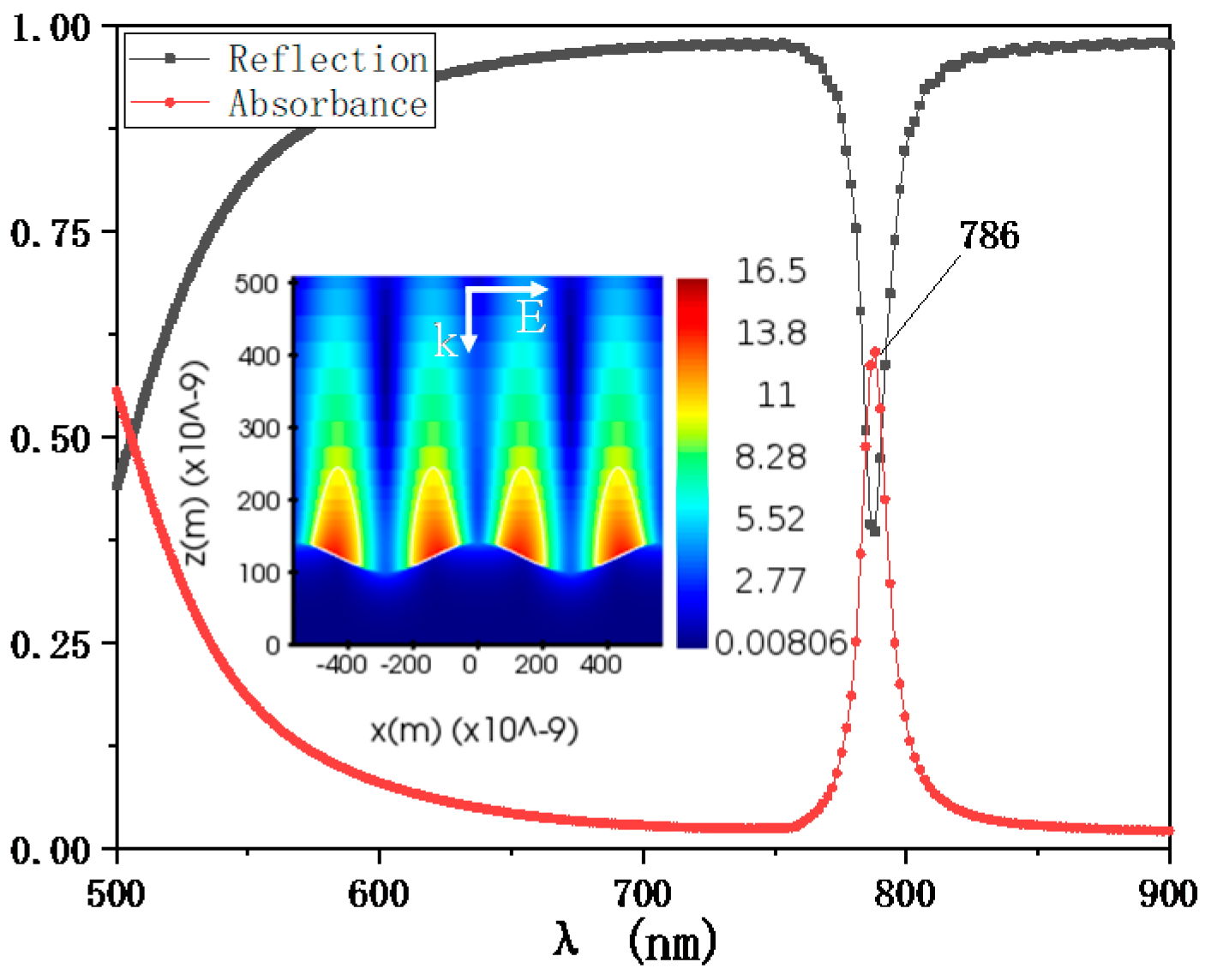
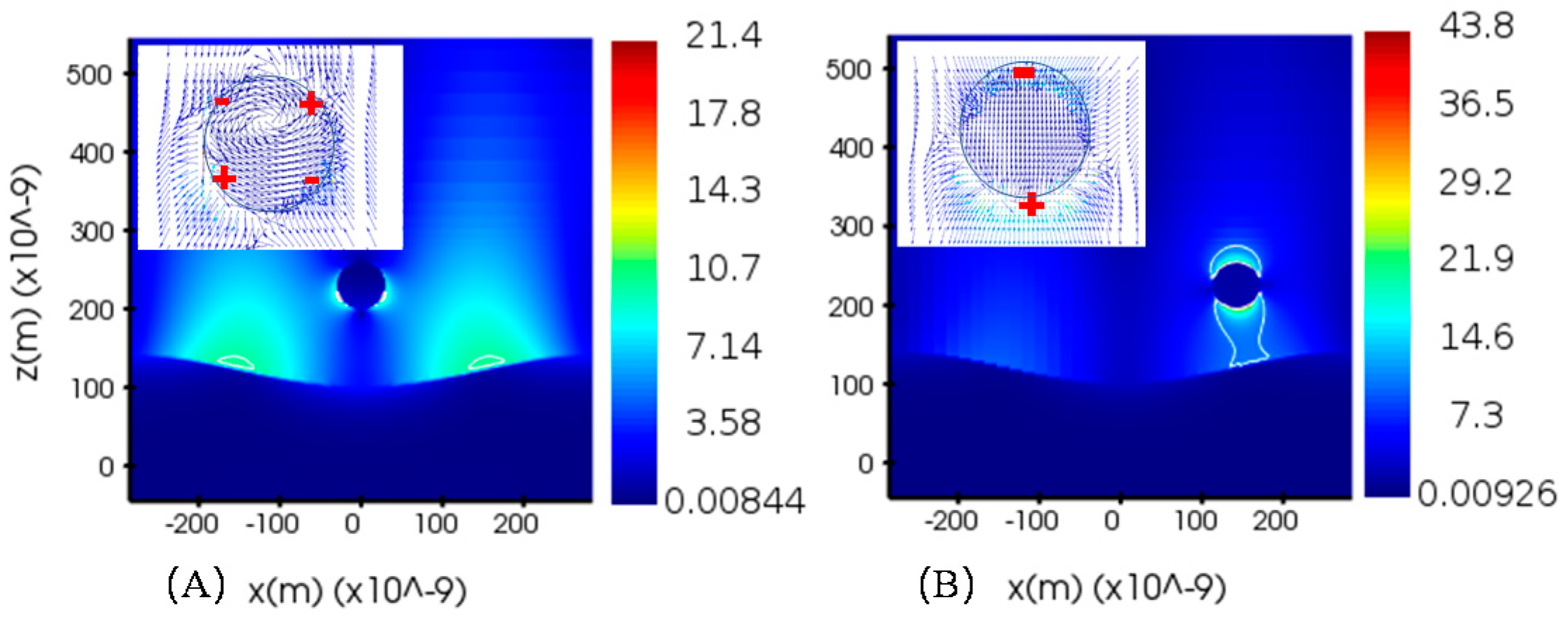

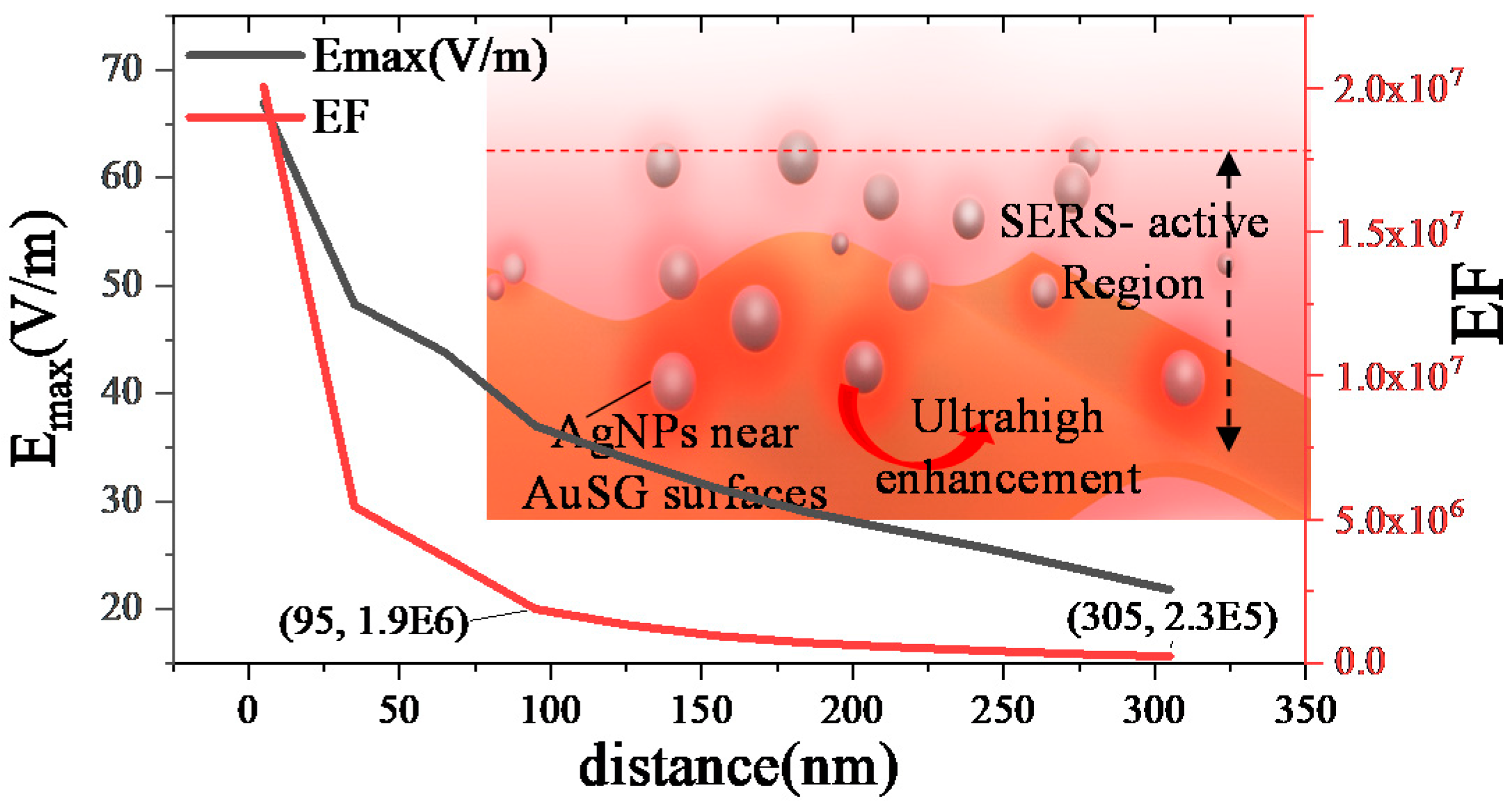
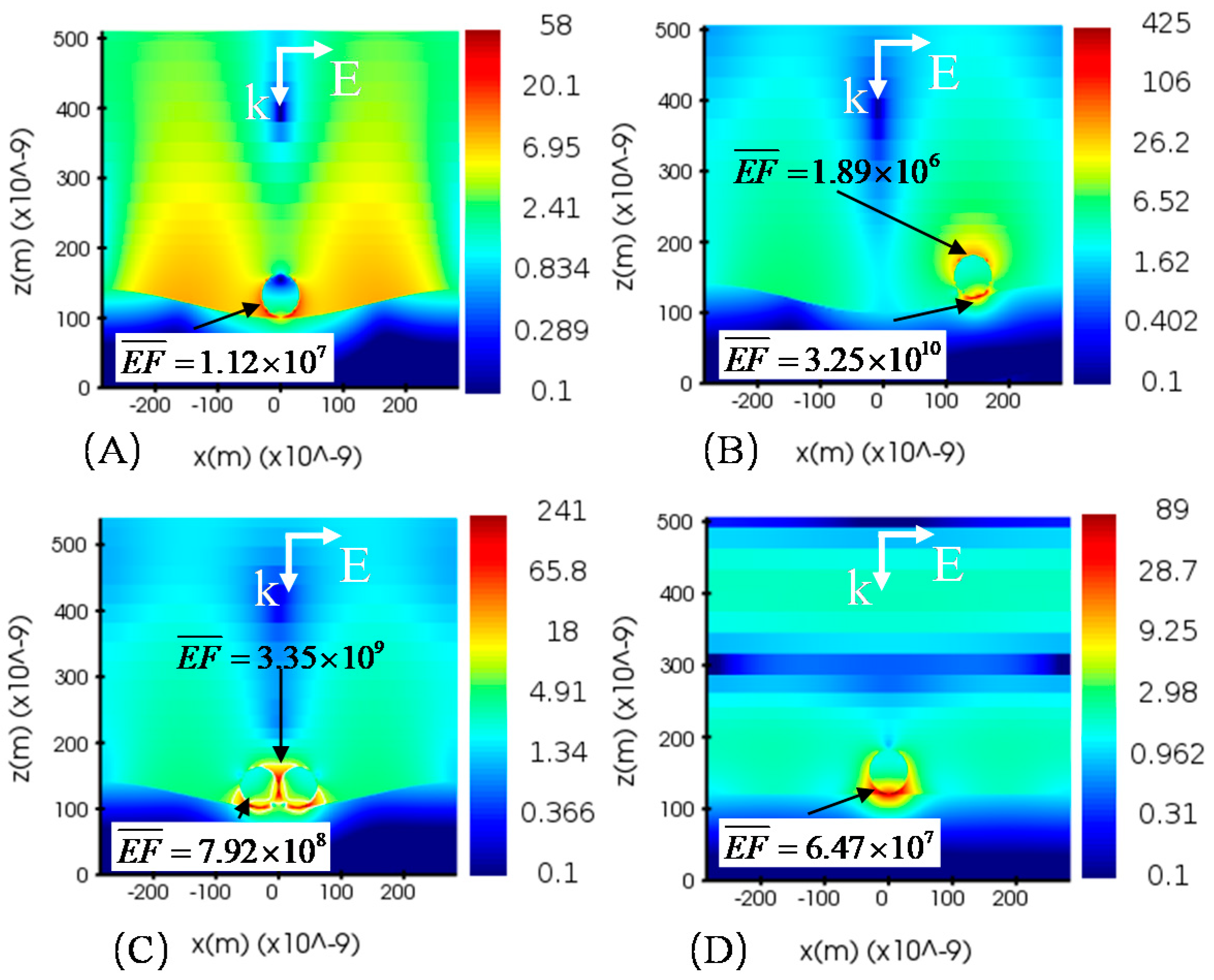

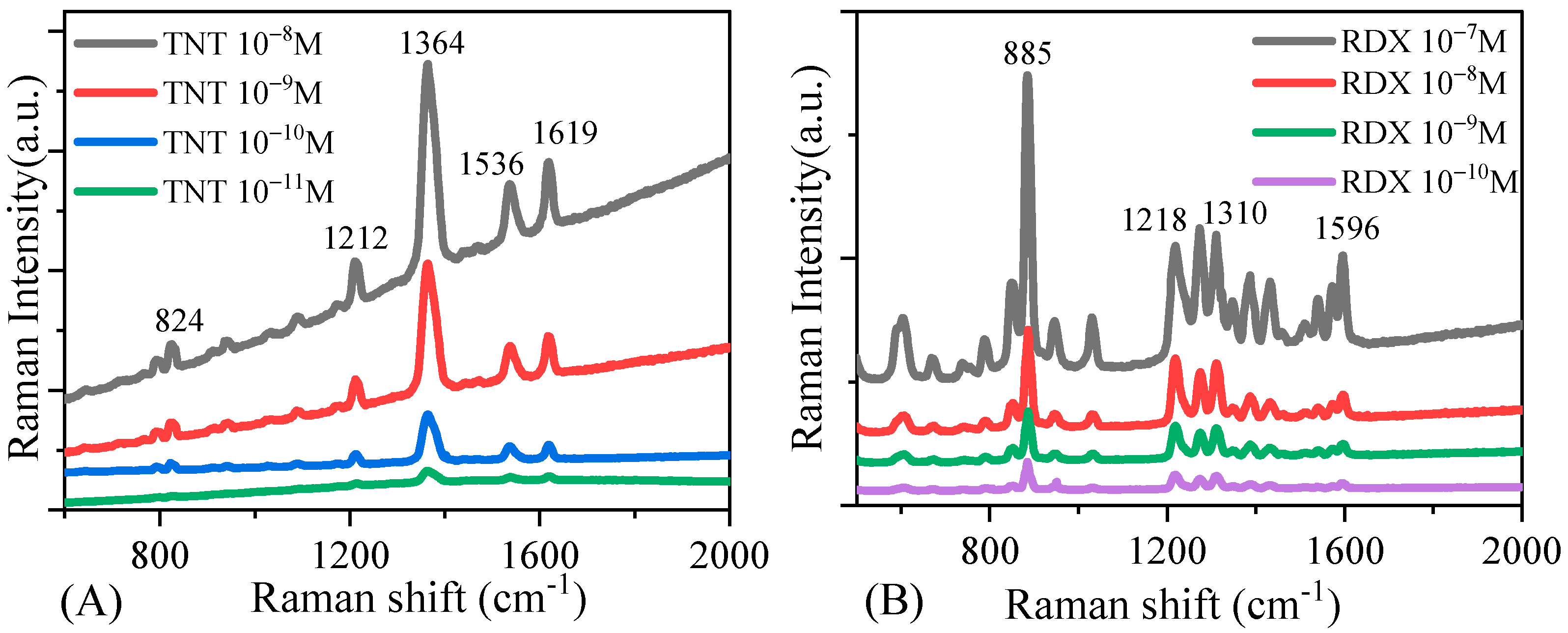
Publisher’s Note: MDPI stays neutral with regard to jurisdictional claims in published maps and institutional affiliations. |
© 2021 by the authors. Licensee MDPI, Basel, Switzerland. This article is an open access article distributed under the terms and conditions of the Creative Commons Attribution (CC BY) license (https://creativecommons.org/licenses/by/4.0/).
Share and Cite
Feng, K.; Chen, Z.; Chen, Z.; Shen, J.; Li, H. Composite Structure of Ag Colloidal Particles and Au Sinusoidal Nanograting with Large-Scale Ultra-High Field Enhancement for SERS Detection. Photonics 2021, 8, 415. https://doi.org/10.3390/photonics8100415
Feng K, Chen Z, Chen Z, Shen J, Li H. Composite Structure of Ag Colloidal Particles and Au Sinusoidal Nanograting with Large-Scale Ultra-High Field Enhancement for SERS Detection. Photonics. 2021; 8(10):415. https://doi.org/10.3390/photonics8100415
Chicago/Turabian StyleFeng, Ke, Zhaoyi Chen, Zhibin Chen, Jinxing Shen, and Huanliang Li. 2021. "Composite Structure of Ag Colloidal Particles and Au Sinusoidal Nanograting with Large-Scale Ultra-High Field Enhancement for SERS Detection" Photonics 8, no. 10: 415. https://doi.org/10.3390/photonics8100415
APA StyleFeng, K., Chen, Z., Chen, Z., Shen, J., & Li, H. (2021). Composite Structure of Ag Colloidal Particles and Au Sinusoidal Nanograting with Large-Scale Ultra-High Field Enhancement for SERS Detection. Photonics, 8(10), 415. https://doi.org/10.3390/photonics8100415




